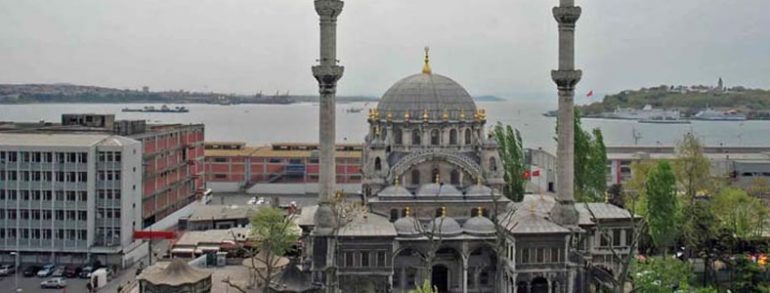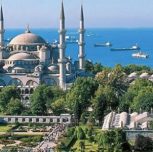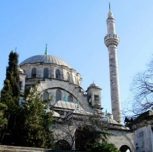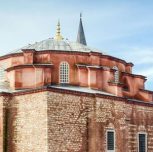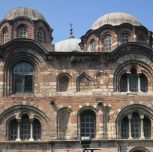There was previously a mosque located on the site of the current Mosque, which was known as the Mosque of the Artillery Barracks (Tophane-i Amire Arabacilar Kislasi Camii) built by Selim III (1789-1807). When that mosque was destroyed by the Firuzaga fire, the Nusretiye Mosque, located on Meclis-i Mebusan Street in the Tophane District of Beyoglu, was built on the order of Sultan Mahmud (1784-1839), and was constructed by the Krikor Amira Balyan. The construction spanned from 1823 and 1826 and was broadly restored between the years of 1955 and 1958, and partially again between 1980 and 1992.
One enters into the harim (sanctum sanctorum) of the Nusretiye Mosque through a palatial baroque style door measuring 4 x 2.10m. The harim is built on a square plan measuring 7.50 x 7.50m and has a ceiling of 33m covered with a pendant dome. There are windows decorated with calligraphy built into the tympana of the grand arches as well as twenty windows around the dome which illuminate the interior from above. The niche of the mihrab is plain when compared to the other elements of the mosque. There are two windows on both sides of the niche of the mihrab, and the mihrab is covered with a half dome which, when viewed from the inside of the mosque, appears as a circle. Additionally, the Nusretiye Mosque showcases the last example of classical Ottoman window arrangement and architecture with its facade including four levels of window rows and marble wall panels ascending to the same level as the window gaps of the second row.
There is obtrusive structure on both sides of the entrance of the mosque called the Hünkar Kasrı (royal residence). It is situated on marble columns with a round arch. It also has an entrance from its rooms to the last prayer section of the mosque and to the outer side porch. The Sultan's entrance is located on the southern facade with a view of the sea. Crowning the aesthetics of the building are the walls of the royal residence which are decorated with a colourful plant motif as well as with calligraphy on its arched-door by the famous calligrapher, Mustafa Rakim (1757-1826).
The mosque has two minarets, each with two sherefes (minaret balcony). In addition to the fountain kiosk erected beside the mosque, which is established a top ten columns supporting a dome, there are two additional structures. These are the muvakkithane (a time keeping room) and a pubic fountain in the courtyard. The Nusretiye Mosque, both with the site on which it was built and its architectural details, showcases an example of mosque architecture definitely worth seeing.


